The Neophyte's Custom Liquid Cooling Guide: How To, Why To, What To Expect
by Dustin Sklavos on September 30, 2013 12:01 AM ESTThe last part of our objective testing is in measuring noise levels, thermals, and power consumption. All of these theoretically go up due to increased voltages on the CPU and graphics cards as well as just the overhead in running the liquid cooling system. Remember that we've added a water pump and essentially increased the number of case fans from three to six.
As I mentioned in my initial review of the Corsair Carbide Air 540, noise levels for the case itself aren't particularly stellar but they're not horrible either. Where we do benefit from the Gigabyte G1.Sniper 5 motherboard is its spacing between the two graphics cards; the board is designed to support four cards, so there's plenty of room for both cards to breathe.
First, we'll take a look at thermals.
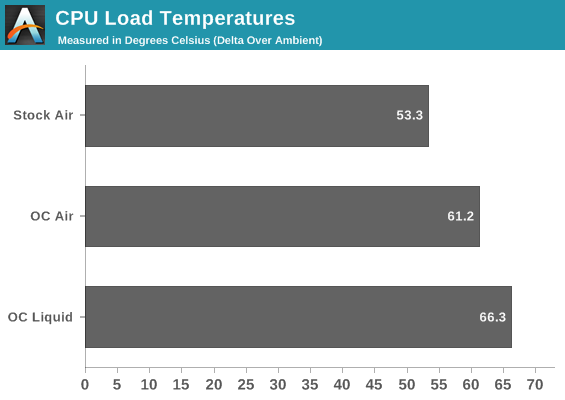
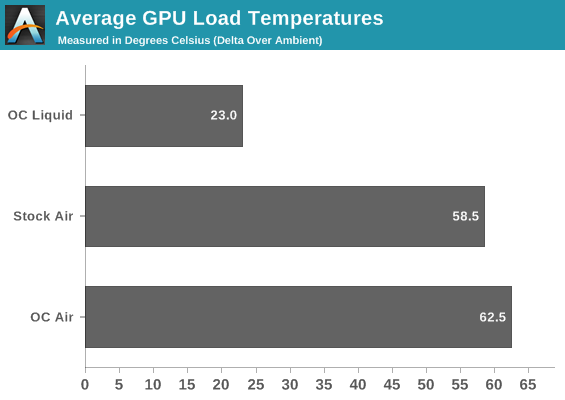
What should be striking is the increase in temperatures on the CPU going from air to water, but remember that we also were able to add a substantial amount of voltage in the process to hit 4.4GHz. Doubly striking is the way the load temperatures on the 780s are more than halved.
Despite the GPUs drawing substantially more power (and thus generating more heat) than the CPU, they also have much higher surface area and less overall heat density. We also benefit from direct contact between the heatsink and the GPU die, while Intel uses poor quality glue and thermal paste to bond the 4770K's die to the heatspreader. Ultimately it becomes too difficult to transfer heat off of the 4770K fast enough.
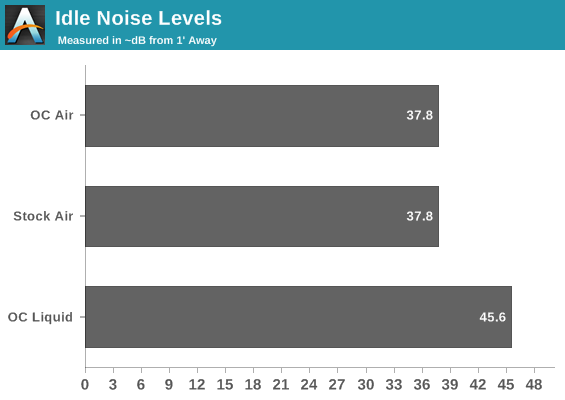
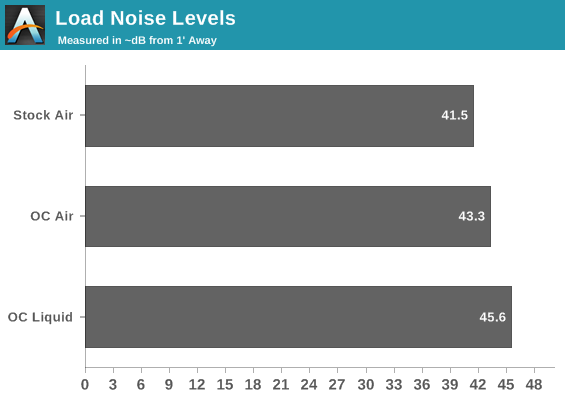
The reality is that none of these noise results are particularly uplifting, but there is a silver lining. If you shift down to 4.3GHz and lose all that voltage that was needed to hit 4.4GHz, you can also reduce the speeds on all of the fans and at least get your noise levels down substantially. Idle noise drops to about 31dB, with load noise closer to 35db or 36db. It's a lot more tolerable.
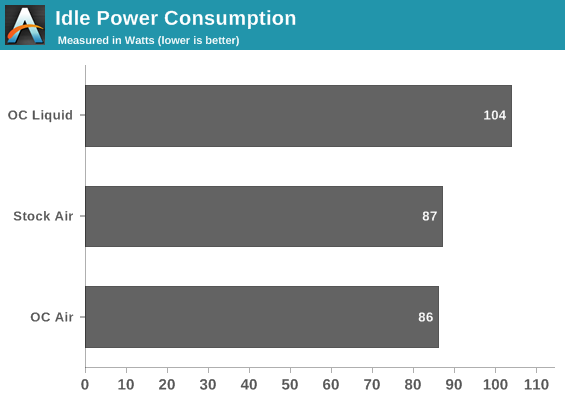

Given the way idle voltages are handled by Haswell and Kepler, it's reasonable to suggest the liquid cooling system adds about 15-20W of overhead as opposed to air cooling. Subtract 20W for the loop, and you're looking at our modest overclock tacking another 30W of power consumption on over the air cooling system. I'm at least a little nervous about what will happen when I flash the BIOSes of the GTX 780s to unlock a small voltage boost down the road.










106 Comments
View All Comments
egotrippin - Monday, October 14, 2013 - link
I'm about to nerd out so forgive me...
Some of the conclusions from this article aren't representative of what you can truly do with water cooling but rather the limitations of the equipment you selected.
For starters, the addition of a pump doesn't automatically mean more noise. The pump you selected can sound like an angry wind up toy and it generates a lot of heat and vibration. A Laing D5 Vario/MCP 655 pump is whisper quiet, especially with a Koolance PMP450 top on it. It can be running at full speed pushing 4.6 liters per minute through the system and so long as it's decoupled properly from any hard surface in the computer case then you wouldn't be able to hear it if it was 6 inches from your ear.
I run a 3930k overclocked typically to 4.4 GHz although I've done higher and if I'm running prime 95 or Intel burn-test my temps are about 66C TOTAL and not 66 DELTA?! If your room is a comfortable 24 C does that mean your CPU temps are 84C on water? Something isn't right. I don't know that chip but maybe it needs to be Delidded and Lapped. I had that same Apogee HD block before on a 3930k which is a much hotter chip and my temps never reached that high.
The fans you are using have a familiar style... because they look just like the Scythe Gentle Typhoons which have the best noise/static pressure of any radiator fan I've seen tested. If you used Gentle Typhoons, temps would be lower and the whole thing would be quiet.
The coolant you used is probably less efficient than distilled water. The only coolant I've used that delivers lower temperatures is Ice Dragon which is heavy and expensive and cuts your flow rate in half. Distilled water works great and it's $1
I can't tell for sure but it looks like small diameter tubing was used. Using 1/2" inner diameter tubing delivers higher flow which means lower temperatures.
Those radiators are anorexic. I don't think they come much thinner than that. Use something with a bit of heft. My rad is 80mm thick which is twice the thickness of those Swiffys. This allows for substantially more cooling and also higher flow rate which, again, increases cooling and lowers noise.
My 3930k + my GTX 690 dual GPU card can both be overclocked and Folding or benching with all cores/gpus at 100% and it can be silent enough that if it weren't for the power light, you wouldn't know it was on. I briefly used air on my GTX 690 and it sounded like a hair dryer and filled the room with the scent of charred air much like the smell of turning your heater on for the first time in winter.
If anybody reads this, you can expect better results if you buy better components. I started off with Swiftech because they were cheap and also they were carried at my local MicroCenter. I quickly graduated to better parts. The Apogee HD is an excellent water block and the Swiftech MCP35X2 and MCP655 pumps are both excellent pumps (but neither were used here).
prismatics - Wednesday, October 16, 2013 - link
Why did you only post OC Liquid benchmarks? I'm interested in Non-OC liquid numbers. I have no interest in overclocking, I just want the quietest, most efficient system.mc2k4 - Tuesday, December 31, 2013 - link
Terrible article, would put off anyone from watercooling. Those results are horrendous.woogitboogity - Wednesday, January 22, 2014 - link
I did a custom build CPU/Northbridge/GPU with the cooling loop going outside the case to the reservoir about 5 years ago...I will admit that when the thing ACTUALLY worked for a while it was insane... granted it was 5 years ago but even then seeing lukewarm temperatures on essentially every component at full load was pretty impressive.
BUT... I feel that one thing missing from this article is a reality check: I work in experimental physics and I have had to work water cooling and even liquid helium cooling for magnets. 5 years ago the vendors of water cooling hardware implied a LOT more than they could back up in practice... since then their claims have only gotten more extravagant. At least in the days when people did water cooling from scratch they did not have marketeers offering false assurances in the form of warranties that clearly do not cover damage due to other hardware.
BOTTOM LINE: I think the subtext of this entire article that needs to be clear is that custom water cooling should be treated as a VERY expensive hobby. Expect to lose every component... period. If that is not an acceptable outcome don't do it. I say this because I deal with experimental cooling all the time and I got burned by the sub-par cooling hardware offered not too long ago (same hoses and cooling block designs... still using water).
Drittz121 - Friday, February 28, 2014 - link
Just do yourself a favor. STAY AWAY from this company. Yes they look good. But when it breaks and it WILL. All they do is give you the run around. They have had my system for over 2 months trying to fix the garbage they sell. Worse company out there for support. DONT BUYalpha3031 - Sunday, June 22, 2014 - link
What about these new Devils Canyon chips?